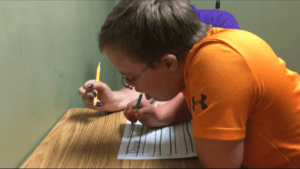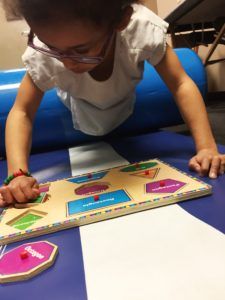Prewriting Tips To Grow On
1. By a young age, encourage your child to color and explore using paper and crayons as this is an integral part of your child’s prewriting and fine motor development. Continue working on purposeful scribbling, coloring in large/small shapes, drawing (specifically people), and using your child’s creativity throughout his/her childhood.
2. By 2 years old, your child should begin grasping writing utensils in palm and imitating vertical lines.
3. By 2.5 years old, your child should be able to grasp a pencil with thumb and fingers instead of a fist and begin drawing horizontal lines.
4. By 3 years old, your child should begin drawing circles stopping within ½” of the endpoint and making crosses (+).
5. By 3.5 years old, your child should begin drawing X’s.
6. By 4 years of age, your child should begin having a static tripod grasp (grasp using 3 fingers but limited movement within fingers/wrist).
7. By 4.5 years of age, your child should begin to draw squares.
8. By 5, your child should begin drawing triangles and writing numbers 1-5 and capital letters of his/her first name.
9. By 5.5, your child should be able to write numbers 1-10 and all capital letters.
10. By around 6.5, your child should be able to write all lower case letters and have developed a dynamic tripod functional grasp.
If by 4, your child is demonstrating difficulty with holding a writing utensil (pencil, crayons, markers) with 3 fingers and maintaining a functional grasp, it is beneficial to use broken crayon pieces or color/write on a vertical surface as these two activities encourage use of a functional grasp.
Additionally, if your child is still demonstrating difficulty, there are hand strengthening activities you can complete to work on strengthening the specific muscles needed to hold/maintain a functional grasp:
1. Use tweezers to pick up small objects
2. Play with playdoh
3. Use thera-putty
4. Engage with interlocking construction toys such as tinker toys or bristle blocks
5. Encourage water play with spray bottles, water guns, squirt toys, sponges, etc.
6. Clothes pin games
7. Hole punch activities
8. Squeeze toys and activities such as using glue
9. Weight bearing activities such as completing activities in prone (on stomach), wheelbarrow walking, animal walks, etc.
**Pencil grips should be used a last resort when teaching a child to hold a writing utensil as this hinders the development of functional grasp.
If you are having concerns or if you child is not progressing like you think s/he should, please do not hesitate to contact ABC Pediatric Therapy and specifically ask for an occupational therapist for more ideas geared towards your specific needs and if you have any additional questions or would like a free screening. Visit our website at www.abcpediatrictherapy.com to find the location nearest you.
 Skip to content
Skip to content